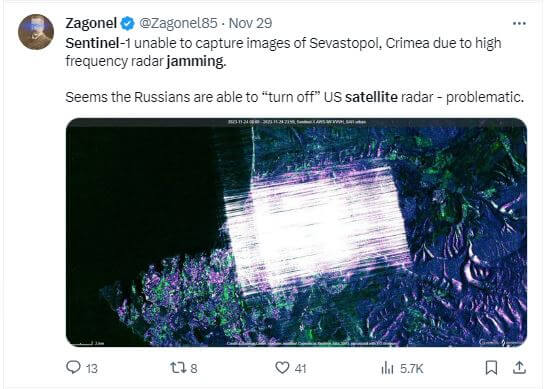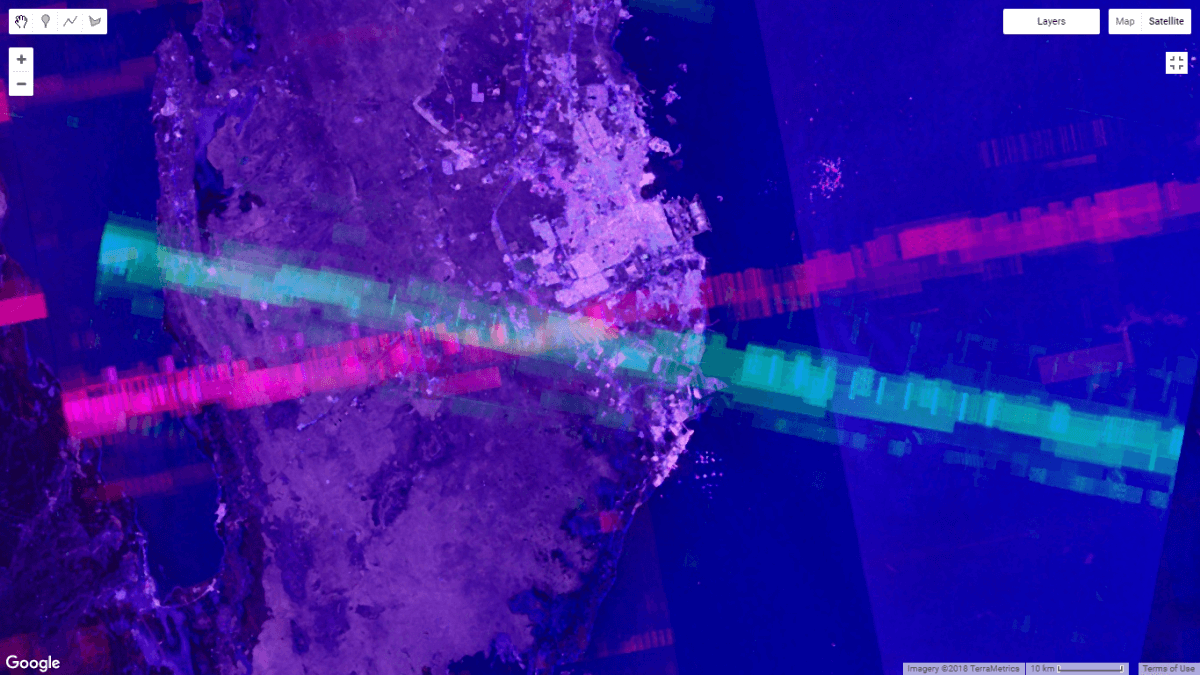
Allegations have emerged that Russian electronic warfare systems are deliberately jamming the ESA’s Sentinel-1A Earth observation satellite as it flies over Ukraine. Are they true?
The European Space Agency’s Sentinel-1A satellite carries a Synthetic Aperture Radar (SAR) transmitting on a C-band frequency of 5.405 gigahertz/GHz. Reports emerged in November that the satellite’s SAR payload had experienced deliberate interference when flying above parts of Russia’s southern border with Ukraine. As shown in pictures accompanying this article the alleged jamming manifests itself as oblong, coloured strips. The presence of these strips obscures the territory beneath them. Incidents were recorded when the satellite was overflying Sevastopol and parts of the Crimea peninsula in southern Ukraine. These areas are under occupation by Russian forces following Moscow’s second invasion of the country in February 2022.
Social Media quickly saw momentum develop regarding allegations that Russian land forces were deliberately using Electronic Warfare (EW) systems to jam the Sentinel-1. However, one voice did encourage caution before jumping to conclusions. The respected ‘Radio and Nukes’ account on Twitter (@HamWa07) was “not convinced the signals we are seeing in Sentinel-1 are from C-Band jamming.”
Is it possible that Russian land forces are responsible for the Sentinel-1 SAR interference either deliberately or otherwise? C-band radars tend to transmit on frequencies of 5.25GHz to 5.925GHz. Armada has yet to learn of any Russian ground-based EW system which jams such frequencies. Details of Russian land forces EW systems we have identified as having been deployed to Ukraine can be found here.
Patriot Games
Could something else be causing the problem? Interference experienced by the Sentinel-1’s SAR has been documented before Russia’s second invasion of Ukraine. Several academic papers have been published noting that the satellite’s radar transmissions have experienced interference when overflying certain areas. Previous articles blamed the interference on C-band ground-based air surveillance radars. India’s Defence Research and Development Organisation’s Swathi C-band weapons-locating radar was blamed as one culprit. Raytheon’s AN/MPQ-53/65 series ground-based air surveillance radar equipping the company’s MIM-104 Patriot medium-range, high-altitude surface-to-air missile system was blamed as another.
Nuno Miranda and Henri Laur, the ESA’s Sentinel-1 mission manager and head of mission management and product quality respectively, told Armada that “it is not infrequent to have Sentinel-1 radar data contaminated by interferences from ground-based radars and other C-band radar satellite missions.” They added that such interference is likely in an area of conflict where ground-based radars are used intensively: “It happened several times over the current Ukrainian-Russia conflict, as it happened in the past with other conflicts involving different belligerents.” C-band radars “are perfectly legitimate to operate in the same frequency band as that used by the Sentinel-1 radar.” The interference is not considered to be a deliberate act.
The radar theory received further corroboration in 2022 from the Bellingcat investigative journalism website. Bellingcat noted patterns of Sentinel-1 SAR interference across the Middle East with the blame pinned on AN/MPQ-63/65 radars deployed in the region equipping Patriot batteries there. Why the interference appears as a stripe on the imagery was explained by Bellingcat. If the satellite is passing overhead when the radar is switched on, it receives both the echoes from its own radar pulses and the pulses transmitted by the radar. The interference is shown as a stripe perpendicular to the satellite’s path. The stripe covers an area measuring 135 nautical miles/nm (250 kilometres) by 2.7nm (five kilometres).
Russian Land Forces deploy a plethora of SAM systems to protect their formations. The only C-band radar Armada has identified as being deployed by Russian land forces to Ukraine is the 96L6 (NATO reporting name Cheese Board) ground-based air surveillance radar. The Cheese Board equips S-400 long-range/high-altitude SAM system battalions. A Russian S-400 battalion typically possesses two S-400 batteries, with two S-400 battalions comprising an S-400 regiment. It would not be surprising if the S-400, considered a theatre-layer air defence system, had been deployed to Crimea. A single system could provide air defence across all of Crimea, much of the surrounding area and unoccupied parts of Ukraine. Given the 96L6’s circa 162nm (300km) range, this radar could cover an area of 282,743 square nautical miles (969,783 square kilometres).
Spurious Events
The ESA has taken some measures to mitigate the interference through filtering, “however, spurious events remain visible like the recent ones over the Ukrainian-Russian conflict area,” say Messrs. Laur and Miranda. Fortunately, “these spurious events are not jeopardising the Sentinel-1 primary mission objective.” Russia and Ukraine have energetically contested the electromagnetic spectrum and continue to do so. However, the interference experienced by the Sentinel-1 appears to be one instance where this is not deliberate. Instead, it seems most likely that it is a consequence of 96L6 transmissions.

by Dr. Thomas Withington













